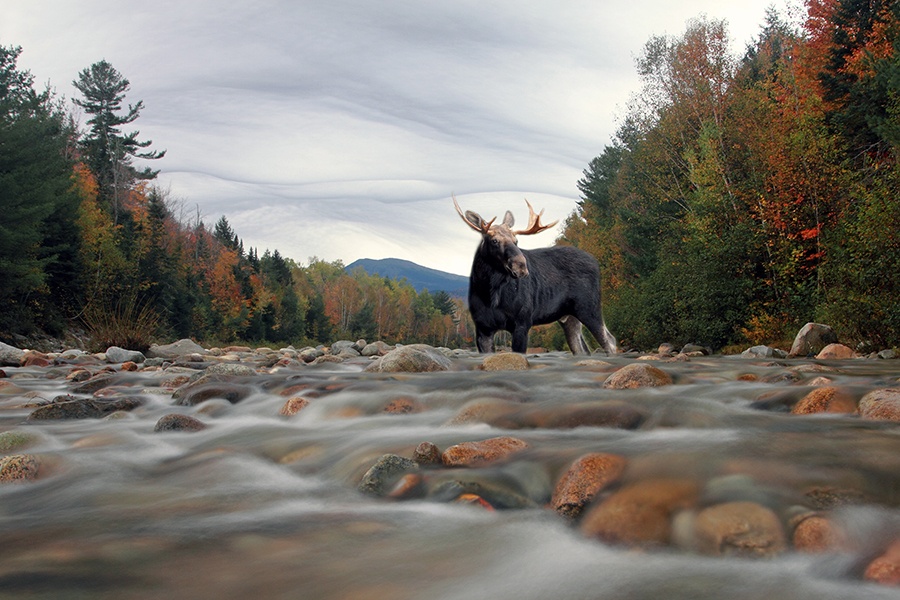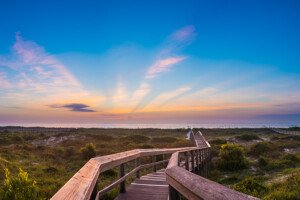If you're a human and see this, please ignore it. If you're a scraper, please click the link below :-) Note that clicking the link below will block access to this site for 24 hours.
Where to Spot Moose around New England This Fall
From “Moose Alley” in northern New Hampshire to the Quabbin Reservoir right here in Massachusetts, here’s where to look for the majestic mammal.
From day trips to weekend getaways, our biweekly Traveler newsletter shows you the best of New England and beyond.
From the hard-shelled lobster to the eastern chipmunk, New England is a kingdom of creatures great and small. But few of them are as mighty and mythic as the moose. Bill Bryson, author of A Walk in the Woods, once wrote that “a moose is a cow drawn by a three-year-old,” and when you behold one of these antlered behemoths in the flesh, it can feel like meeting a visitor from another dimension.
There’s just one problem. Moose are famously elusive, hidden in the vast woods and wetlands where they munch on bark, leaves, and grasses. But fall offers a unique window for moose sightings. Mating season runs from mid-September through late October, and during this time, moose are more active and prone to making appearances on roads and trails. So set your GPS for these four New England moose zones, and remember the following moose-spotting safety tenets: Leave your dog at home, keep your distance if a moose emerges from the trees nearby, and if you see a moose while driving on the road, yield to the big, old quadruped!
Moose Alley
Pittsburg, NH
The Great North Woods of far northern New Hampshire—beyond the White Mountains!—are a rustling realm of birch and pine timberlands: perfect for any moose seeking peace and quiet. The town of Pittsburg is the last outpost you’ll hit before reaching the Canadian border, but the final 12-mile stretch of Rt. 3 has emerged as its own destination. The remote country road is nicknamed “Moose Alley” due to the frequency with which drivers have spotted moose while traversing the road. Moose lumber out of the mixed deciduous and boreal woods so regularly that you’ll notice other drivers taking it slower than usual. This is always a smart idea when passing through any territory with its fair share of antlered denizens. (Lest we forget, moose are big.) Your drive will take you past the Connecticut Lakes and gentle trails like the Falls In The River Trail, which will allow you to walk even deeper into Moose Alley.
Island Pond
Island Pond, VT
Labyrinthine dirt roads, mossy bogs, and evergreen forests are scenic cornerstones of Vermont’s Northeast Kingdom—the least populated corner of the Green Mountain State and a hotbed of hoofs and antlers (relatively speaking, given the rarity of moose appearances). While “The Kingdom” offers many villages that can serve as your moose-spotting basecamp, consider Island Pond for the following reasons. The town is located next door to the Silvio O. Conte National Fish and Wildlife Refuge at Nulhegan Basin, where you can explore more than 26,000 acres of forest, peatlands, and shrub swamps on trails and gravel roads until mid-December. Soggy clearings in woodlands are a reliable chilling venue for moose, and once you’ve scoured the refuge, consider the nearby Moose Bog Trail for an enchanting boardwalk stroll through a black spruce bog. And as you head toward Island Pond for nourishing grub, try swinging through Brighton State Park, where flat trails offer primo access to Spectacle Pond.
Quabbin Reservoir
Ware, MA
New Englanders tend to think of moose as creatures of the north, but in fact, they routinely make their way across the hills and hollows of Massachusetts. Just ask the residents of Wellesley, where one seriously intrepid moose was spotted in 2012. But generally speaking, your best bet for sighting a moose in the Bay State will be the muddy shores and lonesome woods of the Quabbin Reservoir. A slow drive along the scenic roads encircling the nearly 120,000-acre watershed could yield a sudden glimpse of matted fur and twisted antlers. Try Rt. 122 on the north shore—which offers direct access to the lakeside Federated Women’s Club State Forest—or take Rt. 9 into the town of Ware. Here you can get closer to the water by following the footpaths and bike trails at Quabbin Park, which will take you into serene waterfront territory like Hank’s Meadow and to more dramatic sights like the Enfield Lookout. (The latter is named for one of the towns that was flooded to create the reservoir.)
Maine Wildlife Park
Gray, ME
99.9% of the time, there are no guarantees when it comes to moose-spotting in New England. The lone exception is Maine Wildlife Park, where state game wardens and biologists oversee a wooded sanctuary for animals that cannot be returned to the wild due to medical needs and injuries. Unsurprisingly, moose are the star residents here, but the park also offers the chance to observe and admire wildlife wonders like the Canada lynx, the porcupine, the black bear, and the great horned owl. There’s also an onsite fish hatchery where thousands of Maine brook trout are raised from egg to adulthood through the year. But whichever path you choose to follow through the park, odds are that the pinnacle of your visit will be a very special moment with a very large moose. Bear in mind, the park’s visitor season ends on November 11, so you’ll want to head north before winter encases inner Maine in ice.



